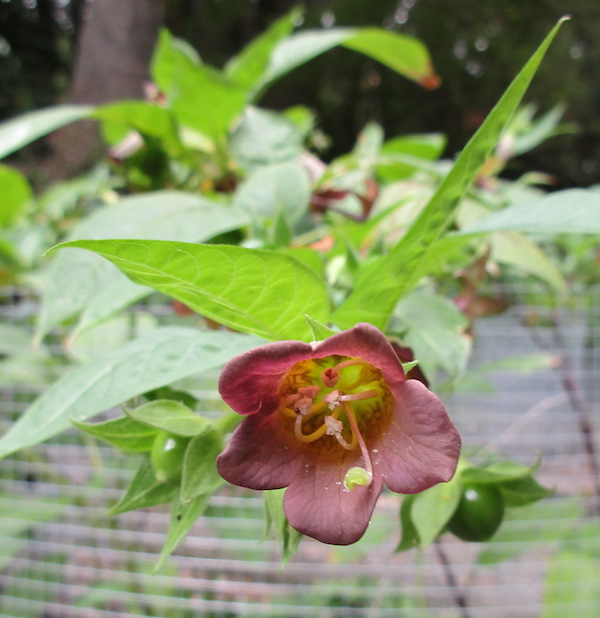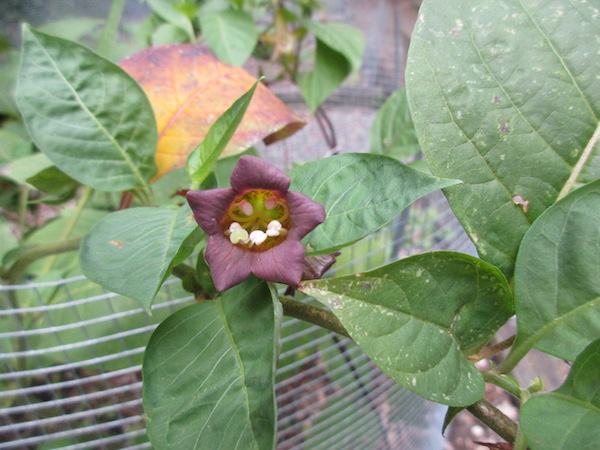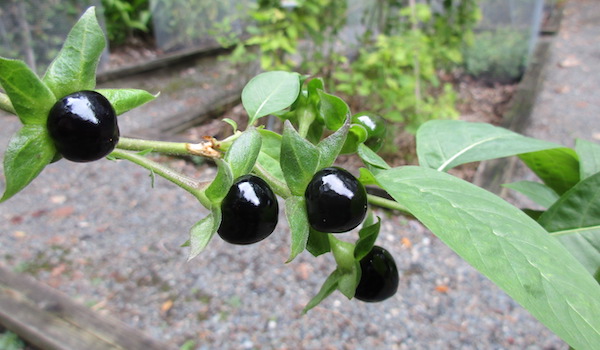| Back in 1985, my first of 100 weed-of-the-month articles was Bittersweet Nightshade (Solanum Dulcamara L.), featured as my November 1985 Weed of the Month, because I was tired of people in Seattle calling it Deadly Nightshade. |
| The name Nightshade is fascinating, evoking dread from most people, who hear scary things about it. In Greek mythology, Atropos was one of the three fates --"the blind Fury with the abhorred shears," who cut the thread of life. The Language of Flowers assigns five meanings to nightshade: (1) falsehood, (2) dark thoughts, (3) sorcery, (4) witchcraft, and (5) scepticism. Consider the words of Gerard, originally penned almost 400 years ago: "Nightshade causeth sleep, troubleth the mind, bringeth madnesse if a few of the berries be inwardly taken, but if moe be given they also kill and bring present death. If you will follow my counsell, deale not with the same in any case, and banish it from your gardens, and the use of it also, being a plant so furious and deadly." |
| Atropa Bella-donna, a European perennial, is happily exceedingly rare in the Seattle area. The University of Washington Medicinal Herb Garden has grown it for more than 100 years (I photographed it there), and the only wild specimens noted in or near Seattle are within three-forths of a mile away—presumably spread via birds. It truly lives up to the other ominous names: Death's Herb, Dwale, Belladonna, Raging Nightshade, Naughty Man's Cherries, and Dog Berries. It grows 3 to 5 feet tall, with leaves 3 to 8 inches long. The bell-shaped flowers are greenish or dull brownish-purple, and 1 to 1 and a quarter inches long. They are solitary or paired in the leaf axils, from May onward. Shiny black berries, one half to three-quarters of an inch long, follow. A child eating three, may die. |
| The drug atropine, used to dilate pupils, comes from this plant. |
| The truth is: Some of the other Nightshades are good. You can fearfully avoid all, or learn who's who. Of our local Seattle Nightshades, the deadly species is literally outnumbered a million to one. |
At least 22 Solanum Nightshade species around the world have been eaten. I lack time at present to state synonyms, distribution, and sources, detailing what parts are eaten --this sort of detail is in my Edible Houseplants book explaining why it is still unfinished after 14 years.
|
| S. americanum Mill. |
(Black or Common Nightshade. Glossy Nightshade)
|
| S. chenopodioides Lam. |
(Velvety Nightshade. Whitetip Nightshade)
|
| S. coactiliferum J. Black |
(Western Nightshade)
|
| S. diphyllum L. |
(Twoleaf Nightshade)
|
| S. elæagnifolium Cav. |
(Silverleaf Nightshade)
|
| S. interius Rydb. |
(Plains or Inland Black Nightshade)
|
| S. jamaicense Mill. |
(Jamaican Nightshade)
|
| S. luteum Mill. ssp. alatum (Moench) Dostál |
(Shrub Nightshade)
|
| S. nigrescens Mart. & Gal. |
(Western Black-Nightshade. Greenspot Nightshade)
|
| S. opacum A. Br. & Bouché |
(Green-berry Nightshade)
|
| S. physalifolium Rusby |
(Green or Hairy Nightshade)
|
| S. ptychanthum (ptycanthum) Dun. |
(Eastern Black or West Indian Nightshade)
|
| S. robustum H. Wendl. |
(Shrubby Nightshade)
|
| S. scabrum Mill. 1768, non Jacq. 1798, R. & P. 1799 |
(African or Black Nightshade. Garden Huckleberry)
|
| S. sisymbriifolium Lam. |
(Sticky Nightshade)
|
| S. tarderemotum Bitt. |
(Black or African Nightshade)
|
| S. triflorum Nutt. |
(Cutleaf or Three-flowered Nightshade)
|
| S. umbelliferum Eschsch. |
(Purple, Chaparral or San Diego Nightshade)
|
| S. villosum Mill. |
(Red-fruited Nightshade. Orange-berry Nightshade. Yellow-berry Nightshade. Woolly Nightshade)
|
| S. violaceum Ort. |
(Indian Nightshade. Asian Nightshade)
|
| S. viride Sol. ex Spreng. 1807, non R. Br. 1810, non Schur 1866 |
(Cannibals' Nightshade)
|
| S. Wendlandii Mill. |
(Costa Rican Nightshade)
|
As usual, I here supplied only a brief introduction for you. My key point is that simplistic, black & white ideas such as all Nightshades are bad, can be flat out wrong.
Back |

Atropa flower and unripe berry ; photo by ALJ
|

Atropa flower ; photo by ALJ
|

Atropa ripe berries ; photo by ALJ
|

